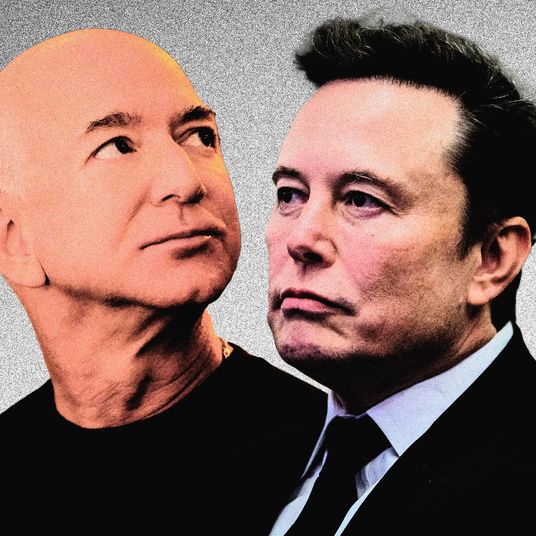
For some buyers, Apple Vision Pro’s most compelling use is one that Apple didn’t advertise. It’s a native feature of the device that allows its user to get enormous amounts of attention, in real life and subsequently online, by simply wearing it in public.
For a few days, there was probably no better bet for producing a viral video than wearing your new Vision Pro while at a restaurant, strutting down city streets, on the subway, or driving your Tesla. Many of these videos were clearly staged or fake, but the overpowering novelty of the thing means that none of the rest was quite candid, either — it’s impossible to wear one of these things outside of your home without being acutely aware of your performance, at least for now.
These videos meet a clear demand for evidence that Apple’s face computer is as ridiculous as it first looks, while simultaneously making the case for its inevitability. They’re funny! They’re also functionally a form of marketing, and not especially illuminating about how people might use mixed reality devices in the future, or for that matter how they’re using one now. Influencers with monetization schemes — professional extroverts, basically — don’t have much to tell us about Apple’s new introversion machine.
Far more instructive are the conversations new owners are having with each other, from the privacy of their own couches, desks, rec rooms, and basements, where the first few hundred thousand Vision Pros are actually being tested, enjoyed, and eventually removed with the user perhaps suffering some combination of headache, eye strain, and discomfort from the head straps or seal. In Vision Pro forums, and on social media, real owners are exchanging smaller, more private absurdities, discovered as they lounge and pad around their own homes, with, at most, occasional cameos by their families and friends. “Objectively I know that I already look like a huge dork with a giant ski mask strapped to my face,” wrote a user on Reddit. “But I was still embarrassed this weekend when I had to stick a straw in my wine glass.” Soda cans are doable; coffee mugs are not. The first must-have Vision Pro accessory is a very long metal straw:
The second must-have accessory is some sort of DIY strap. Apple makes a big soft band that goes behind your head and a helmet-retention-system-style “dual loop” band that goes over your head; owners find the first one unsupportive and the second one uncomfortable, so they’re improvising. Zip-tying two of the soft bands together “really allows your blood to flow around your head.” (Owners are already sharing 3-D-printing templates for fabricating more permanent double-strap solutions.) One guy put together a system for suspending his Vision Pro from a hat brim, for “[h]igher fov (field of view), better weight distribution,” and “open periphery” (one common complaint about Vision Pro is that using its cameras can feel like “looking through binoculars”).
In contrast with public viral theatrics, user accounts of the Vision Pro are more poignant than off-putting. Each excited or bewildered observation posted from within the helmet implies, instead, a series of gently absurd vignettes, observed by nobody: a user sitting on the edge of his bed for hours, pinching his fingers in the air; a man at a desk missing the rim of his cup with his lips before clonking it into his headset; a guy “holding” a video in front of his face, like an invisible tablet, so he can keep watching while he walks around his kitchen; the user who has discovered, he believes, the best way to use Apple’s new mixed reality computing platform, supine on a bed with the lights on:
I’ve been wearing it laying down like 75% of the time. Much more comfortable for me. Only time I sit up are when there’s a need to (watching stuff in immersive environments) and exploring with putting windows around my house and stuff. Laying down is the way to go IMO. Head propped up sofa armrest/pillow.
Among new Vision Pro owners, there’s a telling fixation on the physical experience of using the device — on the the physical realities of a face computer. (One user asked, “Am I going crazy or is there a sensation of touch when you manipulate a window close to your hands?” No, another owner replied, not at all: “I think it’s our brains thinking it should be feeling something.”)
Granted, for most people, strapping on a headset is going to be a novel experience. There’s a lot to figure out, or get over, before you start to actually use it, and even Apple’s legendary marketing department couldn’t avoid conveying the new strangeness, or at least strange newness, of AR headset use in situ. For its announcement, Apple suspended theoretical users in floating display cases, where they sat, with great posture, in little dioramas filled with nice furniture:
Now, more realistic versions of these scenarios like this are unfolding in home offices around the world. “Have had the Vision Pro one day and discovered you can’t use it at all in a completely dark room (ie lying in bed next to your spouse who is sleeping),” writes one user. It’s “a little unsettling to someone who has a dog,” writes another. “I can’t really see him and I guess I didn’t expect to but it’s weird to not interact with him as much as I would if I was sitting at a computer.” One owner’s cat kept confusing hand gestures for offers of treats that never came. (Possible solution: Vision Pro for pets?) There are fully positive experiences that are nonetheless fundamentally unmarketable:
[L]ast night, I was lying in bed, in a VR environment, looking at the stars, in crystal clear clarity, with a small window open talking to a friend via Messages, and just beyond that, mounted in the sky, was a 100 foot wide screen which had The Social Network running in simply the clearest quality I have ever seen outside of 15/70 IMAX.
Most interesting are owners’ debates over what, exactly, they just purchased. Is the Vision Pro for watching movies? Working? Being alone? Collaborating? Nobody knows, really. Rather than settling into a new routine, or building a workflow around their new computers, users spend a lot of time talking in the future tense, about what this thing might do once there are more apps, or once it’s smaller and lighter and better, or once it’s normalized among the broader population. More than a few users are writing reviews along the lines of, “this is a really amazing device that blew my mind when I first used it,” and it “has SO much promise,” while also declaring their intention to return it after a few days.
For Apple, a massive public company that is taking a sizeable risk on a new product category, this perhaps isn’t the ideal response. It calls to mind to the era of consumer technology just before the iPhone came out, when various manufacturers were still figuring out what to do with nascent touchscreen technology, slow but functional mobile internet connections, shrinking hard drives and processors; like Taco Bell rearranges the same dozen ingredients into new menu items every few years, consumer tech companies were releasing seemingly randomized permutations of Things With Batteries And Screens, assuming that at some point one of them would stick. The way people are talking about the Vision Pro now is a lot like how early adopters talked about portable personal-media players with little screens, lots of buttons, and FM radio, or tiny little “netbook” laptops, or “HTPC” home media computers: as categories that feel like they have a lot of vague potential, and which in hindsight had a lot to tell us about what was coming, but which were, at the time, mostly interesting as gadgets — as tools, sure, but mostly as objects of fascination for enthusiasts, who relish above all the feeling, whether or not it’s rooted in reality, that they’re exploring some sort of (controlled, consumerist, expensive) frontier.
For a product marketed in futuristic terms, it’s putting some users in a nostalgic frame of mind. “What a breath of fresh air,” writes one owner. “In a decade of desolation from [Apple], this device is truly something special.” Another writes, “I haven’t had such joy to experience new piece of technology since the original iPod back in 2001.” For early adopters, the pointlessness is sort of the point. Look what happened with smartphones! Gadgets are a lot more fun when you don’t have to own one.































